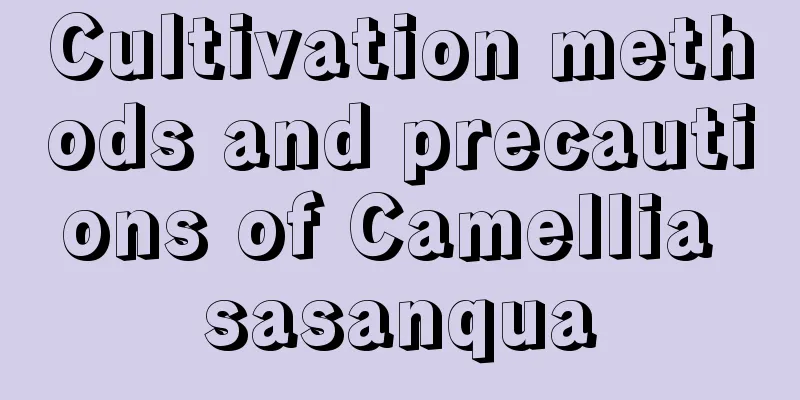Cultivation methods and precautions of Camellia sasanqua

|
Camellia sasanqua is an evergreen small tree of the Theaceae family Camellia genus, but it is different from the camellia we usually call. It is a semi-sun-loving and semi-shade-loving plant and has strong shade tolerance, but long-term exposure to a dark environment may result in no flowering or less flowering. Let’s learn about the cultivation methods and precautions of Camellia sasanqua. 1. Soil selection Camellia sasanqua is suitable for growing in loose, fertile, well-drained acidic sandy soil with a pH value between 5.5-6.5. When potting in northern regions, you can choose a culture soil composed mainly of leaf mold or peat soil, with a small amount of river sand added. A small amount of well-rotted compost or organic fertilizer can be added to leaf mold, perlite , river sand, etc. to increase the nutrients in the soil. 2. Lighting management Camellia sasanqua is a semi-shade plant and is suitable for growing under soft light. In summer, shade is needed to avoid strong sunlight. In late autumn and winter, more sunlight is needed. You can choose to expose it to light in the morning or evening, avoiding direct sunlight. 3. Watering tips Water when the soil is dry and wet, and water thoroughly. Avoid watering in the middle. In summer, water the plants once in the morning and evening every day, and in winter, water them once every few days. Except in winter, you should spray water on the leaves every few days to keep them clean. 4. Fertilization method Generally, apply thin nitrogen fertilizer 1-2 times in February and March to promote the growth of branches and leaves; apply thin cake fertilizer water once in April and May to promote flower bud differentiation; apply phosphorus fertilizer once in September and October to make the flowers larger and more colorful. Fertilizer should be light and fully decomposed, avoid applying raw or concentrated fertilizer. 5. Trimming After the flowers fade, remove the remaining flowers in time to reduce nutrient consumption. Generally, one flower bud is left on each branch, and the rest are thinned out to concentrate the nutrients. 6. Notes Although Camellia sasanqua likes sunlight, it cannot be exposed to direct sunlight, otherwise it will cause leaf burns. During the growing period, the soil needs to be kept moist, but not too moist to avoid root rot. The suitable temperature for growth is between 18-25℃. Too low or too high temperature will have an adverse effect on its growth. Camellia sasanqua has relatively few diseases and pests, the main diseases include gray spot, sooty mold, anthracnose, etc., which must be prevented and controlled in time. In short, the soil of Camellia sasanqua needs to be changed every 2-3 years, because the soil in the pot tends to become compacted, affecting the growth of the plant. Changing the soil can also prevent soil alkalinity, and prune the roots when changing the soil to promote plant growth
|
<<: The breeding methods and precautions of Jinyumantang
>>: Fuchsia cultivation methods and precautions
Recommend
The difference between sunflower and sunflower
1. Height difference Sunflowers are generally 1-3...
How to eat Hericium erinaceus and who is not suitable to eat it
1. How to eat 1. Cooking and Stir-frying: Stir-fr...
Planting conditions and techniques for durian honey
Introduction of Durian Honey Durian honey, also k...
Clivia cultivation methods and techniques
Clivia is a very popular indoor foliage plant. Be...
How to plant everlasting chrysanthemum
Seed selection Choose seeds that are of good qual...
Is it better to use a large pot or a small pot for roses? What size pot is suitable?
If roses are planted indoors, it is recommended t...
Do Hostas prefer shade or sun?
Do Hostas prefer shade or sun? Hosta is easy to g...
What are the benefits of eating leeks? What are the benefits of eating leeks for men?
1. Nutritional supplement Chives contain a lot of...
How to grow Dancing with the Wind in autumn
1. Control the temperature It likes warmth. If th...
How to grow camellia in autumn
1. Picking buds When growing it, in autumn, you m...
Tiger Pilan cultivation methods and precautions
Tiger Pira , a popular potted plant in homes, has...
Where does eggplant grow?
Eggplant growth habits Eggplant is an annual herb...
When is the best time to plant wild rice?
Fried water bamboo shoots with meat and fried wat...
How to prune the hard-boned trumpet creeper
When to prune the hard-boned trumpet creeper It i...
How to fertilize Duzhanchun
Exclusive spring fertilization method: In fact, o...









